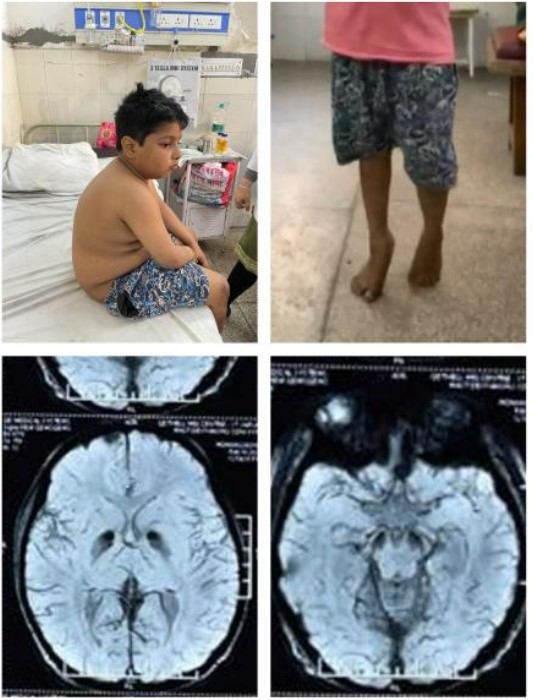Objective: While phenotypic spectrum of Neurodegeneration with brain iron accumulation is quite diverse, we discuss a case with peculiar axial hypotonia, a pointer towards PLA2G6 associated degeneration (NBIA-PLAN).
Background: Childhood genetic disorders have a myriad of clinical presentations, and its difficult to convincingly bank upon physical findings for a diagnosis in patients of this age group. We herein describe axial hypotonia as a pointer towards NBIA type 2B. The genetic analysis proved the diagnosis later.
Method: We present a 8 year old male child, with delayed motor and language milestones and had a poor scholastic performance. Since he started walking at 4 years of age, he had progressive difficulty walking with frequent dragging of feet and tripping while waking. His heels did not touch the ground due to heel contractures , and patient walks on toes at present. He had tremulousness of upper limbs, soiled his face and clothes while eating and drinking. Examination revealed slurred scanning speech, normal eye movements and other cranial nerves. Tone was increased in lower limbs with ankle contractures, decreased in shoulder, elbow, wrist, hip and trunk. He used to sit in couched manner due to truncal hypotonia. Neck flexors > extensors were slightly weaker than limbs. Deep tendon reflexes were normal in upper limbs, bilaterally brisk in lower limbs with ankle clonus with extensor plantars. Mild finger nose ataxia and heel shin impairment was seen with mild truncal titubation. Gait was narrow based and dragging of both limbs with toe walking.
Results: MRI Brain revealed T2 hypodensity in bilateral globus pallidus, substantia nigra alongwith cerebellar atrophy. Nerve conduction studies, and Evoked potentials were reported normal. A whole exome sequencing showed heterozygous mutation (c.1933C>T, p.Arg645Ter) at exon 14 of PLA2G6 gene, characteristic of Infantile neuroaxonal dystrophy 1 (INAD 1), or NBIA 2B.
Conclusion: INAD/ Classical PLAN has an onset age of around 1-6yrs, is associated with early cognitive decline, has associated ataxia, cerebellar atrophy, neuropathy and optic atrophy. Even in presence of spasticity and contractures, axial hypotonia constitutes a unique clinical pointer of the disease. Infact, truncal hypotonia may be an early and predominant manifestation, sometimes leading to consideration of spinal muscular atrophy in the differential diagnosis.
References: 1. Hogarth P. (2015). Neurodegeneration with brain iron accumulation: diagnosis and management. Journal of movement disorders, 8(1), 1–13. https://doi.org/10.14802/jmd.14034
2. Guo, Y. P., Tang, B. S., & Guo, J. F. (2018). PLA2G6-Associated Neurodegeneration (PLAN): Review of Clinical Phenotypes and Genotypes. Frontiers in neurology, 9, 1100.
3. Illingworth, M. A., Meyer, E., Chong, W. K., Manzur, A. Y., Carr, L. J., Younis, R., Hardy, C., McDonald, F., Childs, A. M., Stewart, B., Warren, D., Kneen, R., King, M. D., Hayflick, S. J., & Kurian, M. A. (2014). PLA2G6-associated neurodegeneration (PLAN): further expansion of the clinical, radiological and mutation spectrum associated with infantile and atypical childhood-onset disease. Molecular genetics and metabolism, 112(2), 183–189.
4. Kurian, M. A., Morgan, N. V., MacPherson, L., Foster, K., Peake, D., Gupta, R., Philip, S. G., Hendriksz, C., Morton, J. E., Kingston, H. M., Rosser, E. M., Wassmer, E., Gissen, P., & Maher, E. R. (2008). Phenotypic spectrum of neurodegeneration associated with mutations in the PLA2G6 gene (PLAN). Neurology, 70(18), 1623–1629.
To cite this abstract in AMA style:
VM. Mathur, DK. Khandelwal, DS. Sharma, AG. Gupta. Axial hypotonia – A pointer towards NBIA – PLA2G6-Associated Neurodegeneration [abstract]. Mov Disord. 2022; 37 (suppl 2). https://www.mdsabstracts.org/abstract/axial-hypotonia-a-pointer-towards-nbia-pla2g6-associated-neurodegeneration/. Accessed May 14, 2025.« Back to 2022 International Congress
MDS Abstracts - https://www.mdsabstracts.org/abstract/axial-hypotonia-a-pointer-towards-nbia-pla2g6-associated-neurodegeneration/

